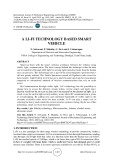
Data communication concepts
-
Smart car deals with the smart collision avoidance between the vehicles using visible light communication. The basic concept behind this technique is that the data can be transferred through LED light by varying light intensities faster than the human eyes can perceive.
 9p
9p  lucastanguyen
lucastanguyen
 01-06-2020
01-06-2020
 26
26
 3
3
 Download
Download
-
Data and the Binary Code System ‘Data’, a plural noun, the term used to describe information which is storedand processed by is in computers. It is essential to know how such data are represented electronically before we can begin to understand how it can be communicated between computers, communication devices (e.g. facsimile machines) other data storage or devices. As a necessary introduction to the concept of ‘digital’ transmission, this chapter is devoted to a description of tha method of representing textual and numeric information which is called the ‘binary code’. ...
 11p
11p  huggoo
huggoo
 20-08-2010
20-08-2010
 105
105
 6
6
 Download
Download
CHỦ ĐỀ BẠN MUỐN TÌM














